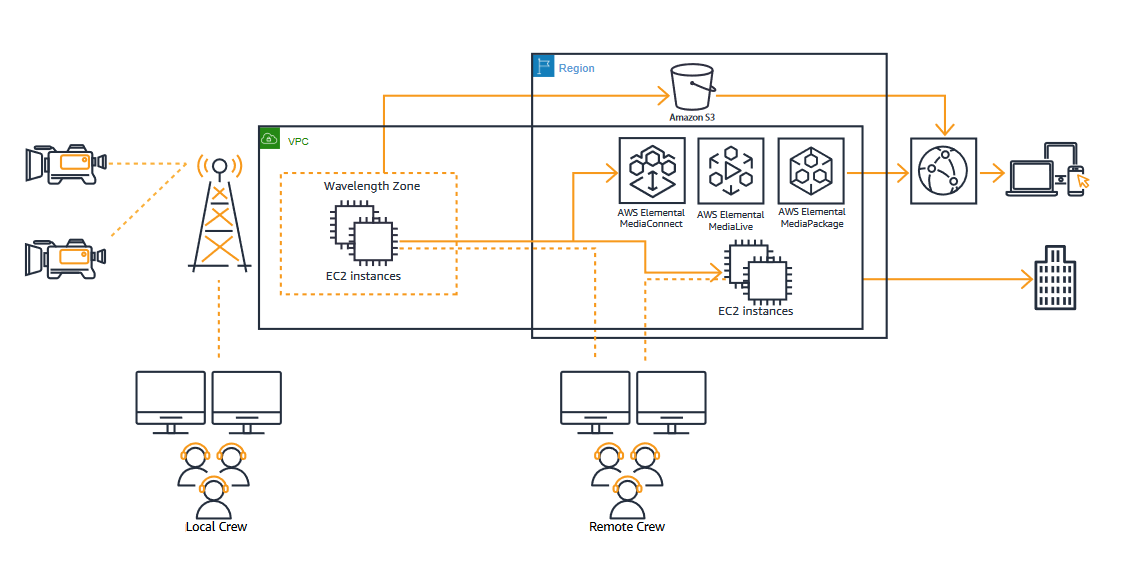AWS Architecture Blog
Catch Important Moments in Sports with 5G and AWS Wavelength
To enhance the viewing experience for spectators, fans, and players, the sports industry is continuously evaluating ways to lower video latency. With 5G, networks can now provide high-density radio (air) interfaces with high bandwidth and reliability.
This new technology especially benefits sports broadcasting and player tracking and analytics, which need to be processed at the edge. Having these services processed closer to their respective venues means viewers are less likely to miss any exciting and important moments because of lag.
This blog discusses how AWS Wavelength brings AWS Cloud to the edge of the 5G mobile network by providing AWS compute resources, services, APIs, and toolkits. For example, a real-time machine learning algorithm that analyzes a game may appear slow if it runs exclusively in the cloud. Additional latency will be introduced as the application traffic travels across the internet to the cloud.
We’ll show you how to run applications in edge computing infrastructure to provide low latency so viewers like coaches, players, production teams, crew, etc., get a quality viewing experience.
Reducing the travel distance for applications
You can reduce the distance traveled for an application to reach the compute, storage, and cloud services by running applications closer to their endpoints. Accessing these resources in the cloud using traditional mobile architectures requires several stops on the network:
- Device
- Cell tower
- Metro aggregation sites
- Regional aggregation sites
- The internet
- The cloud
Then it has to go back through these stops before getting back to the device. This whole process creates tens to hundreds of milliseconds of latency.
With AWS Wavelength Zones located at the edge of the 5G network, application traffic can reach servers without leaving the mobile network. The network path is shorter from mobile device across the communication service provider’s packet core before reaching AWS Wavelength Zone:
- Device
- Cell tower
- Metro aggregation sites
- Regional aggregation sites
This path is highly controlled by quality of service (QoS) and routing in cloud service provider (CSP) networks; the latency is predictable and has less jitter.
AWS services, 5G, and video production at the edge
The combination of 5G and mobile edge computing can dramatically change how the sports industry creates, captures, manages, and distributes content, especially for live events.
Before 5G, on-site production created content, which was typically sent via internet, fiber, and satellite, usually with redundant paths.
As shown in Figure 1, our solution uses 5G to ingest produced content into the AWS Wavelength Zone where localized overlays, closed caption, and personalized graphics are added. Cloud production workflows such as switching, editing, and mixing are handled in the AWS Wavelength Zone. Then the content is streamed back to viewers, or it is sent to the cloud for wider distribution via content delivery network (CDN).
Taking this solution one step further, a fan could choose different viewing experiences. They could choose different camera angles in the stadium that they want to view on their mobile device, with potential augmented reality overlay on the video. Or, for fans in the stadium, they could potentially have their “fan view” added to the final broadcast.
Figure 2 shows how the contribution over 5G can be provided to compute instances in AWS Wavelength Zones. Video switching, audio mixing, and graphics are operated by a local crew connected directly to the 5G network or a remote crew connected via an AWS Region.
AWS services, 5G, and IoT-based sports analytics
Currently, most sports leagues are using optical and IoT-based sensors for player tracking. These sensors traditionally use RFID-based tags and chips.
Leagues or teams use this data for player health and performance, officiating, game planning, training, and product development. This data can also be used to drive in-game augmentation and potentially support in-game real money gaming (where legal). Resiliency and low latency are critical in these cases because we need quick and accurate data to make decisions.
Summary
In this blog, we discussed how you can enhance the viewing experience for your customers and examine sports analytics with 5G.
We showed you how to ingest encoded video over 5G from venues to the AWS Wavelength Zones for video production. We also talked about applying innovative augmented reality overlays and graphics and stream this content back to the fans for an immersive in-stadium experience.
Then we talked about how sports industry customers like broadcasters, leagues, and teams are adopting 5G-based technology to analyze games. They collect data through 5G connected devices and IoT sensors, and then using machine learning to further personalize in-venue experiences and game event prediction.
If you want to learn more about how 5G technology can deliver the next generation of mobile entertainment, review AWS Wavelength for Media & Entertainment.


